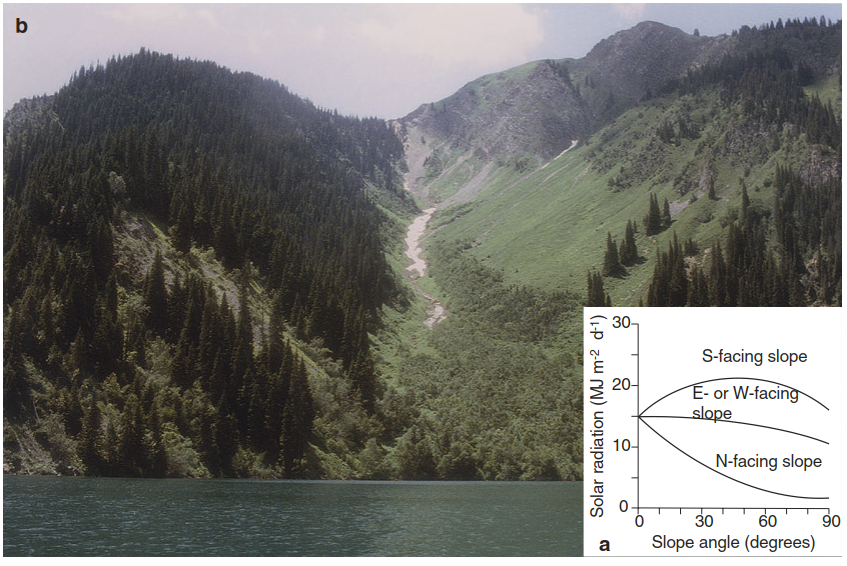Modification of Environmental Radiation and Temperature by Abiotic Factors
Daily variations of temperature at the soil surface and average annual temperatures are affected by the soil conditions and site exposure (Chap. 18).
Heat conductivity and heat storage in soil: Dry soils have low heat conductivity and warm substantially faster at the surface during the day, because of incoming short-wave solar radiation, and cool greatly during the night, as the incoming (re-emitted) long-wave radiation is mainly balanced by the outgoing long-wave radiation from the soil. Moreover, in dry soils, heat exchange is limited to a small volume. On limestone near Wurzburg, Germany, maximum surface temperatures of 60 °C have been measured (Kraus 1911). In contrast, wet soils have high heat conductivity and heat capacity, and thus lower daily amplitudes of temperature. Because of the higher evaporation and thus larger evaporative cooling effects on wet soils, their annual average temperatures are lower than those of dry soils.
Optical characteristics of surfaces: Absorption of incoming radiation is increased on black surfaces of rock or humus; reflection is increased on white mineral soils and with snow cover. With black organic cover, soil surface temperatures of more than 50 °C have been observed even in alpine climates. On organic soil exposed to the sun, the temperature tolerance of seedlings is often exceeded (e.g. beech seedlings are damaged at the soil surface and collapse).

Fig. 9.5 Impact of slopes on incident solar radiation. a Influence of the orientation of a slope on the potential incident radiation (excluding clouds) at 55° latitude (after Jones (2014)). b Subalpine vegetation (2500-3000 m above standard zero) in the northerly Fergana mountain range (41°N in Sari Chilek, Kyrgyzstan) with a differentiation of the vegetation on the north- and south-facing slopes: Picea schrenkiana on the north slope, meadows on the south slope. The shrub vegetation (Rosa, Lonicera, Berberis) of the valley is a consequence of the increased snow and soil moisture
Exposure and slopes: In the northern hemisphere, north slopes receive less radiation than south slopes—that is, they do not warm up as much at midday (Fig. 9.5a). South slopes receive radiation maxima according to the latitude of the site and the slope inclination. Slopes cool less during the night than the bottom of the valley, because cold air is heavier than warm air and flows downhill into the valley. The radiation budget of the slope is also more favourable during the night than in the valley, as re-radiation inputs from neighbouring slopes positively influence the radiation budget. Thus, vineyards at their northern growth limit are found on south-facing slopes, not in the valley. The climatic differences between north- and south-facing slopes in the northern and southern temperate climates may be large enough to cause differences in the local vegetation (Fig. 9.5b).
Depth and moisture of soil profile: Temperatures are much more constant within the soil than at the soil surface (see above). Depending on soil moisture, which determines the soil heat capacity, there is a clear seasonal shift of changes in soil temperature in comparison with air temperatures, with soils being generally cooler than the air during spring and early summer but warmer in autumn and early winter.
Date added: 2025-02-01; views: 244;
